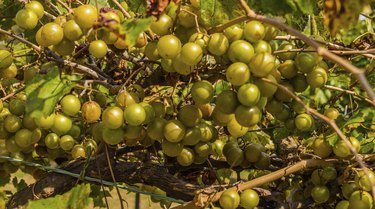
Florida's heat and humidity take their toll on the kinds of grapevines (Vitis spp.) most commonly grown in areas farther north, making them difficult if not impossible to grow in the state. Two kinds of grapes, however, withstand the challenges of the climate and grow well in Florida. They're the best grapes to grow in Florida, if you're set on having some in your home garden.
Florida Hybrid Bunch Grapes
Video of the Day
The species of grapes most commonly grown in northern climates, such as the European grape (Vitis vinifera), are hardy in U.S. Department of Agriculture plant hardiness zones 5 through 9 so are not well-suited to the humid Florida climate. Also, many grape species are susceptible to Pierce's disease, a bacterial infection that is fatal to afflicted vines and common in the southern United States. Grape growers, however, developed hybrids of European grape and native U.S. grape species that are resistant to Pierce's disease and better able to survive in Florida's heat and humidity. These varieties are sometimes collectively referred to as Florida hybrid bunch grape (Vitis vinifera x Vitis spp.).
Video of the Day
"Blanc du Bois" is a commonly grown variety of Florida hybrid bunch grape. It is hardy in USDA zones 6 through 10 and, therefore, can be grown in most of Florida, which ranges from USDA zone 8a in the north to USDA zone 11b in the keys off the state's southern tip.
Because bunch grapes produce relatively large clusters of tightly bunched fruits, they are vulnerable to problems such as fungal infections and rot. So they are somewhat more difficult to grow in Florida's humidity than grapes that produce smaller fruit clusters.
Native Muscadine Grapes
Muscadine grapes (Vitis rotundifolia Michx.) are also well-adapted to the Florida climate. The species is native to the southeastern United States and hardy in USDA zones 6 through 10. It is effectively immune to Pierce's disease and, because muscadine fruit clusters tend to be small, is less susceptible to rot and fungal problems than most varieties of bunch grapes. Its fruits' distinctive flavor, however, makes it less well-suited for wine-making.
Commonly grown muscadine varieties include "Fry," "Nesbitt," "Noble" and "Summit."
Growing Conditions for Florida Grapes
Both muscadine and Florida hybrid bunch grape grow best in full sun and sandy, well-drained soil with a pH level of about 6. Grapevines survive in areas with at least an annual average of 30 inches of rainfall, which applies to all of Florida, but the plants produce better when each is given supplemental irrigation of 2 to 4 gallons of water per day, especially during dry periods.
Optimal spacing between the plants depends on the layout of the planting area. Typical spacing, though, is 10 to 15 feet between plant rows and then 12 to 20 feet between muscadine plants within a row and 8 feet between other bunch grapes within a row.
Fertilizer Needs for Grapes
These grapes also benefit from the regular application of fertilizer. At planting time, 1/4 pound of bone meal in each planting hole will help vines get established. Apply 1/4 pound of an 8-8-8 dry fertilizer when the plants produce new growth in spring, scattering the fertilizer in a 1-foot-wide circle around the base of each plant. Repeat that dry fertilizer application in June and August. In the second year, increase the dry fertilizer application rate to 1 to 2 pounds per vine, and apply it in March and either June or July. In subsequent years, increase the application rate to 3 to 4 pounds per plant.